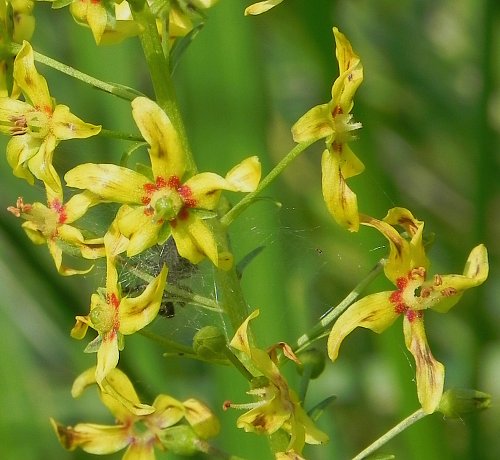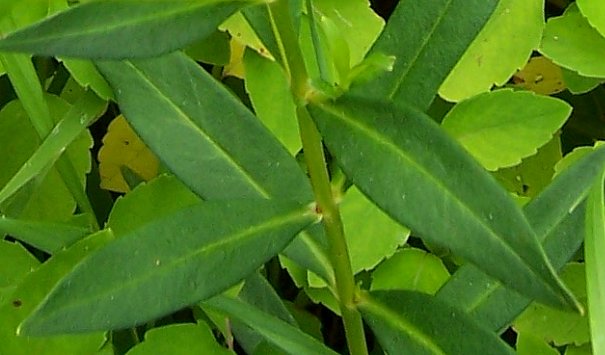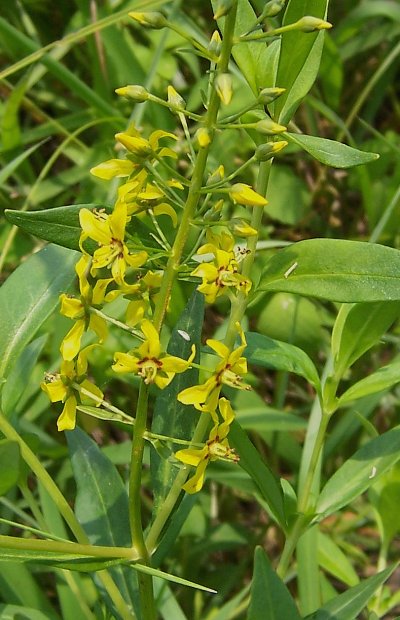
Each flower is about ½–¾" across, consisting of a light green calyx with 5 deep lobes, a yellow corolla with 5 deep lobes, 5 stamens, and a green ovary with a single style. The lobes of the calyx are lanceolate to ovate in shape, glabrous, and about one-third of the length of the corolla's lobes. The petaloid lobes of the corolla are elliptic-oblong in shape; they have pairs of small reddish patches at their bases. The stamens have white filaments that are joined together at their bases by a ring-like structure that is light green. The outer side of this structure, the lower corolla lobes (facing outward), and filaments are glandular-oily. The slender pedicels of the flowers are ½–¾" long, light green, either glabrous or appressed-pubescent, and slightly to moderately ascending. Sometimes, instead of flowers, this plant produces aerial bulblets in the axils of the upper leaves during the summer. These bulblets are up to ½" long, ovoid in shape, and reddish brown; they eventually detach from the mother plant and fall to the ground. The flowers bloom during early to mid-summer, lasting about 2-4 weeks for a colony of plants. Afterwards, the flowers are replaced by ovoid seed capsules that are 3-4 mm. long. These capsules are few-seeded. Individual seeds are quite small (about 1–1.5 mm. in length). The root system is rhizomatous. Clonal plants are produced from either the rhizomes or bulblets.

Cultivation: The preference is full or partial sun and wet to moist conditions; different kinds of soil are tolerated. The easiest method of propagation is by bulblets or the division of rhizomes, rather than seeds.
Range & Habitat: The native Swamp Candles is found primarily in the northern half of Illinois, where it is uncommon (see Distribution Map). Habitats consist of various wetlands, including marshes, swamps, low areas along ponds and streams, fens, and bogs. This plant is normally found in high quality natural areas.
Faunal Associations: The flowers of Lysimachia spp. attract Melittid bees, which collect floral oil and pollen for their larvae. In Illinois, Macropis steironematis appears to be the most common Melittid bee. Other bees, particularly small Halictid bees, also visit the flowers occasionally to collect pollen. Information about floral-faunal relationships about Swamp Candles is rather limited, however some insects are known to feed on this plant. These insects include the larvae of a sawfly (Monostegia abdominalis), a weevil (Acallodes lysimachiae), the Poplar Vagabond Gall Aphid (Mordwilkoja vagabunda), and the polyphagous Foxglove Aphid (Aulacorthum solani); see Price (1970), Fall (1913), and Blackman & Eastop (2013).

Photographic Location: A fen in Fayette County, Illinois. The photographs were taken by Keith and Patty Horn (Copyright © 2014).
Comments: This is one of the more attractive Lysimachia spp. because the flowers are more conspicuous and less likely to be hidden by foliage. Species in this genus are highly unusual because their flowers produce floral oil, rather than nectar. Swamp Candles (Lysimachia terrestris) can be distinguished from other native Lysimachia spp. by its showy racemes of flowers; usually the latter produce flowers from the axils of their leaves. A non-native species, Lysimachia punctata (Spotted Loosestrife), also produces showy racemes of flowers, but its leaves are usually whorled and more broad, while the petaloid lobes of its flowers are more broad and overlapping than those of Swamp Candles. Swamp Candles occasionally hybridizes with 2 other Lysimachia spp., producing plants with intermediate characteristics. These naturally occurring hybrids include Lysimachia × commixta (Lysimachia terrestris crossed with Lysimachia thyrsiflora) and Lysimachia × producta (Lysimachia terrestris crossed with Lysimachia quadrifolia). Other common names of Lysimachia terrestris include Earth Loosestrife and Swamp Yellow Loosestrife.